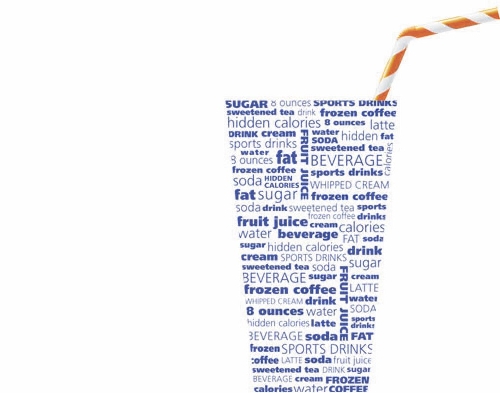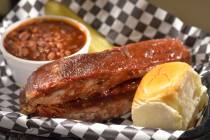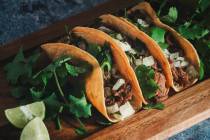High-calorie beverages can throw dieters a curve ball
You've been watching what you eat, trying to walk a little more and taking the steps now and then, and still, you're not losing any weight.
Maybe you should be thinking about what you drink - because there's a good chance you're not.
"I have a private practice, and with weight management it's a very key issue that I have to address," said registered dietitian Laura Kruskall, an associate professor and director of nutrition sciences at the University of Nevada, Las Vegas. "Clients don't think about the calories in beverages - I think it's because it's a liquid and it's one of those things that you're not really chewing."
Joanna Gorman, a registered dietitian with University Medical Center, said beverage intake is a frequent theme with her clients as well.
"They can't understand why they can't get their weight to move," Gorman said. "Normally the first thing I say to them, after I research their food, is, 'And then what do you drink?' Nine times out of 10, it's unknown to them that they are getting anywhere from 500 to 800 calories a day from beverages. I've had people getting 1,000 calories a day from beverages."
Kruskall said a huge calorie boost like that can sometimes come from even one beverage, such as a frozen coffee topped with whipped cream and caramel.
"I think they may think there are calories in it, but I think they don't realize that it could be 500 to 700 calories," she said. "That's what you should be eating in your meal, not just a snack or a beverage or something like that."
Many times, the problem stems not just from the beverage itself, but from the portion size, the dietitians said.
"People are shocked that an average can of soda is 150 calories," Kruskall said. But then consider the matter of free refills. Most people don't think about it when a server brings a pitcher to the table to refill that soft drink, or when they walk to the soda machine and refill their cup several times.
"Sometimes people are taking in more than their calorie needs throughout the day," she said.
Robyn Lew, a registered dietitian with the Sunrise Children's Foundation and an independent consultant, said packaged beverages can be deceiving.
"When you get a bottle of soda or Gatorade, people don't look at the label," Lew said. Many bottles contain two to two-and-a-half servings, but people treat them as one.
"You have to take everything on that label and multiply it by two or two and a half," she said. "It's a lot more calories than you think."
While the dietitians agreed that soft drinks seem to be the worst offenders when it comes to overlooked calories - "because it's so easy to slurp down soft drinks," Kruskall said - other common sources are Gatorade, which has 100 calories in 8 ounces, or sugar-sweetened iced teas and fruit drinks.
And even beverages generally considered healthful can be packed with sugar and calories. Gorman pointed out that there's 60 calories in 4 ounces of orange juice, and most people drink more than 4 ounces, so that 60 calories has to be multiplied accordingly.
"I'm not a big proponent of juice," Gorman said. She does recommend light juices, and said that, for example, 99 Cents Only stores carry light Ocean Spray juices that have 5 calories in 8 ounces, for a total of 20 in a 32-ounce bottle.
"If people like to have their juice, I would shoot for the light," she said. "Try limiting it to 8 ounces of the light juice a day."
A better alternative, they said, is to eat whole fruit instead of drinking juice. Gorman said that by eating the whole fruit you're getting fiber, which is good for you and also makes you feel fuller longer. And, she said, since it takes longer to eat the fruit than it does to drink a glass of juice, the satisfaction lasts longer.
"I always recommend to people that if they want to have juice, they should have the real fruit," Lew said. "Just eat the apple or the orange, because you're going to get the fiber. With the juice, you just get liquid sugar."
Fiber regulates digestion and also has been shown to lower cholesterol, Lew said.
"Most people don't get enough fiber," she said. "You want to have about 30 grams of fiber in your diet a day, and natural fiber is much better than artificial fiber."
Lew said to imagine a garden hose stuffed up with mud and leaves.
"Fiber is the water that would come through," she said. "In the intestines and colon, it comes through and sweeps everything out."
And speaking of water, Lew said to remember the importance of consuming enough of it.
"Especially in Vegas, you still need your eight to 10 glasses a day," she said. "Shoot for at least 100 ounces."
While at least one recent study found that in the case of a bottled-water ban favored by some environmentalists, people turn to bottled soft drinks instead, she said that even in areas where bottled water may not be available, a reusable bottle is a good choice.
"I use a reusable container," she said. "They sell those for a couple of bucks now. I recommend using something like that, or a Nalgene bottle.
"Drink up, drink up, drink up. I encourage people, when they're hungry, to have a glass of water, because sometimes you're just thirsty and that can keep your belly full. If you're getting 100 ounces a day, that can help you stay full."
Contact reporter Heidi Knapp Rinella at hrinella@review journal.com or 702-383-0474.






















